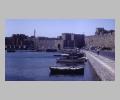| Summary: | Capital city of the island, established ca. 407 B.C. by the cities of Kameiros, Lindos, and Ialysos. |
| Type: | Fortified City |
| Region: | Dodecanese |
Periods:
Classical
Hellenistic
Roman
Byzantine
Modern
Physical:
In 407 B.C. the Rhodian union established the new capital city in a triangular area at the N tip of the island. The city was built on the Hippodamian grid system with streets and underground drains oriented N-S and E-W. The new city walls followed the coasts on the E and W sides of the triangle and became well respected for their strength. At the S base of the triangle, on the landward side of the city, the walls followed the land contours best suited for defense.
Two natural harbors, enhanced by the construction of moles, were located on the E side of the city. The main harbor may have been the location for the Colossus of Rhodes which had been erected in 290 B.C. and was destroyed by earthquake in 225 B.C. North of the central port was a smaller harbor An unsheltered landing S of the port also served the busy maritime activities of the city. On the less sheltered W coast of the city a smaller harbor could be used in good weather.
The terrain of Rhodes rises slightly to a low ridge in the W where the unfortified acropolis is located. The temple of Zeus and Athena and the sanctuary of Pythian Apollo occupy the acropolis and a stadium, gymnasium and small theater are located just below and E of the summit. The main theater of the city is located near the S city wall. Beyond the S wall are the extensive necropoloi of the city.
Description:
At the time of Homer, Rhodes was under the control of the three independent Dorian cities of Lindos, Ialysos, and Kameiros. The early history of the island is not well known, but its location at the S edge of the Greek world insured a rich commerce with Egypt and the East. The three cities of Rhodes, together with the island of Kos and the Anatolian cities of Knidos and Halikarnassos made up the confederation of the Doric Hexapolis.
In 490 B.C. Rhodes came under the control of the Persians. With the defeat of the Persians in Greece, Rhodes was compelled to join the Delian League in 478 B.C., but it resigned from the League in 411 B.C. The three main cities of Rhodes formed a union in 408 B.C. and established the new federal capital at the N end of the island, which they populated with their own citizens. The new city of Rhodes became immediately prosperous as the three older cities declined in size.
In the 4th century B.C. Rhodes submitted first to Sparta, then to Athens, and in 357 B.C. became an ally of Persia. During the 4th and 3rd centuries B.C. Rhodes was one of the greatest commercial and cultural centers of the ancient world. When an earthquake devestated the city in 222 B.C. its reputation as a center of arts and literature drew international aid for its rebuilding.
In the 2nd century B.C. Rome greatly weakened the economic position of Rhodes when it established Delos as a preeminent maritime center and free port. Rhodes continued, however, to remain a center of culture and a major commercial port throughout the ancient and Medieval periods.
Exploration:
The Italians began excavations on the acropolis in 1916 under Maiuri and continued in 1917-1929 under Jacopi and Laurenzi. In 1922-1925 Italian excavations were carried out in the Old City. Since 1951 the Greek Archaeological Service, represented by Kondis have worked in the Old City.
Sources Used:
Other Bibliography:





